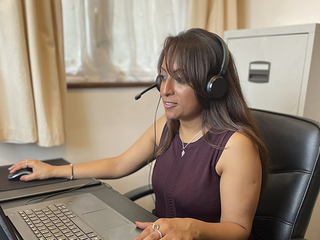Tests after diagnosis
Once you've been diagnosed with CLL, you may have further tests. These tests are designed to give your doctor more information so they can give you the best care.
Why do I need more tests?
- If you don’t need treatment, you will have regular tests to check whether the CLL is stable or progressing.
- If you need to start treatment, you will have tests to help your hospital team decide which treatment will work best for you and monitor how well it’s going.
- You may have scans to check on your symptoms.
- You may also have tests to look at your prognosis – what’s likely to happen in the future.
Having tests can be stressful. It’s normal to feel nervous, whether it’s about the procedure or the results or both. Ask your hospital team or GP to explain what each test procedure involves, what the test is looking for, and how long the results are likely to take.
Our free CLL booklet has information about managing anxiety while you’re waiting for test results.
Blood tests
If you’re on active monitoring for CLL (you’ve never had treatment, or have had treatment and gone into remission), you’ll have blood tests at regular intervals. Samples of your blood will be taken and tested in a laboratory.
Find out more about the different types of tests you'll have below:
At each check-up, you’ll have an FBC to count the number of red blood cells, white blood cells and platelets in your blood.
This calculates how long it takes for the number of lymphocytes in your blood to double. It’s looked at with every full blood count and helps to show if your CLL is progressing, and how fast.
This checks how well your kidneys are working. The results will show if any damage has been caused by the CLL. It’ll also show if you’re dehydrated (lacking fluids).
If you need to start treatment, this test will help your hospital team calculate the dose of drugs you need
This checks if your liver is working normally. It’s particularly important to know this if you need treatment, as drugs are broken down in the liver. If your liver isn’t working normally, your hospital team may need to adjust your doses.
Treatment tests
You’re likely to have these tests only if you’re having treatment for CLL, or if your hospital team needs to find out if it’s time to start.
Bone marrow biopsy
People with CLL may have a bone marrow biopsy to check for abnormalities in the bone marrow – the spongy tissue inside some of your bones where blood cells are made.
For this test, a needle is used to take a small sample of bone marrow from the back of your pelvis (the ring of bones between your waist and the top of your legs). Your doctor will then look at the bone marrow sample under a microscope.
You may have a bone marrow biopsy if your hospital team thinks it will give them useful information about the CLL or its treatment.
Beta-2 microglobulin (B2M) test
This measures the level of a particular protein called beta-2 microglobulin or B2M in your body. Your hospital team may use this test to find out more about the stage of the CLL and your prognosis, or to monitor the progress of your treatment. This test is done using a blood sample and sometimes a urine sample.
"I have had two bone marrow biopsies. The first one was painful, so I was not looking forward to my second. Imagine my surprise and relief when the second one was no more painful than a normal injection."
Mel, living with CLL since 2013
Find out more about having a bone marrow biopsy

Scans
Your hospital team may order scans to investigate certain symptoms or find out how the CLL is progressing, but they’re not done routinely.
Here’s why you may have certain scans after a CLL diagnosis:
- X-rays can be used to check if you have a chest infection.
- CT scans can show which parts of the body are affected by the CLL. You may have a CT scan before and after treatment, depending on your symptoms.
- PET scans can help your hospital team check if the CLL is developing into a different type of blood cancer. This is rare.
We have more information about scans and how they’re done.
Genetic tests
You may have genetic tests look for changes (abnormalities or mutations) in your blood cells. To understand why you might have these tests, it may help to check what you know about DNA, chromosomes and genes:
- DNA (deoxyribonucleic acid) DNA is the genetic code that controls how the cells in our body grow and develop.
- Chromosomes DNA is packaged up in structures inside cells called chromosomes. Almost all of our cells, including most blood cells, contain DNA arranged in 23 pairs of chromosomes.
- Genes These are short sections of DNA which control specific functions of cells. Every human has around 20,000 genes.
CLL and your genes
Cancer develops when genes controlling cell growth are damaged. This damage means that the cancer cells grow faster than normal cells.
Genetic damage is important in the development of CLL, although we usually don’t know why this has happened in an individual person. Here are some of the things we know can lead to DNA damage:
- Chance We all make hundreds of billions of blood cells every day and genes can be damaged or mutated (changed) whenever we make new cells.
- Environment Mutations can also happen if we’re exposed to things which damage DNA, such as chemicals.
- Inherited abnormalities Genetic abnormalities can also be inherited, although this only happens in a small number of people with CLL.
There are several different genetic abnormalities that can lead to CLL. This is one of the reasons why CLL behaves differently in different people. These genetic abnormalities can also influence how the CLL responds to treatment.
Genetic tests can be done on samples of your blood or bone marrow to find out which genetic abnormalities are present in the CLL cells. You’ll usually have these tests at the point where you need treatment.
FISH tests and DNA sequencing are genetic tests that are commonly done at this stage:
This test looks for damage to chromosomes. FISH tests detect chromosome damage in about 80% of people with CLL (8 in 10).
This looks at the genetic code to find changes in individual genes.
Important CLL genes
Changes in certain genes can affect how well treatment works, and what treatment you will be offered.
This is one of the most important genes which can be damaged in CLL cells. About 10% of people with CLL (1 in 10) have mutated p53 or absent p53 (caused by deletion of part of chromosome 17) when they are first treated. Mutated p53 is detected by DNA sequencing and absent p53 is detected by FISH testing.
The p53 gene controls how people respond to chemotherapy, and patients with damaged p53 don’t respond well to normal chemotherapy treatment. But people with p53 abnormalities can be treated effectively with newer targeted drugs such as ibrutinib and venetoclax. See our information on CLL treatments.
Having a mutation of this gene generally leads to better outcomes following treatment. About 60% of people with CLL (6 in 10) have mutated IGHV genes.

Worried about anything or have questions?
If you need someone to talk to, please don't hesitate to contact our Support Service by phone or email.
